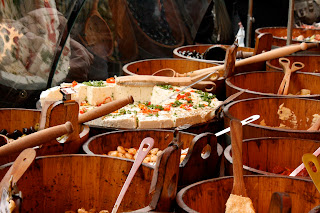"Dyes run, polymers break down and toxic chemicals ooze into the environment."
The procedure of producing clothes is severely wasteful nowadays. A great number of chemicals stay in the water cycle forever which pollutes the environment. Materials such as polyester and other synthetics can also harm the nature due to their everlasting features that take centuries to decay.
Trash Fashion demonstrates how designers can create clothing without waste by experimenting new technology and techniques.
BioCouture
'BioCouture' is made out of cellulose produced by tiny millions of bacteria grown in the bathtubs of sweet green tea which can be a good ecological replacement for Cotton, which requires a great amount of water. The bacteria 'Acetobacter' use the sugar in the green tea to produce floating mats of cellulose. Designer Suzanne Lee utilized this bacteria in order to create her 'BioCouture' clothing. However, this technique has not been in use because "it breaks down a little too easily"(S. Lee).
http://www.youtube.com/watch?v=WVW-jSdhILs
Sugar Rush
This skirt is made out of 'Ingeo'- a 'bioplastic' called polylactic acid (PLA) produced from plant sugar. 'Ingeo' is a great ecological alternative for polyester which is made from oil. Since it is created from plants such as corn, wheat, and sugar cane, it is very possible to reproduce in a short period of time.
Furthermore, the fact that PLA is recyclable can be another solution for the waste problem.
Easier Recycling
Kate Goldsworthy demonstrates cutting, joining, and decorating a polyester dress by using a powerful laser beams. This method is pure and free from chemical coating.
Laser Aperture - creates patterns
It is better to use one type of material which makes it easier to recycle.
Throughout the exhibition, I was shocked by the outrageous amount of material waste and its severe damage on environment. Due to the negative effect, I recognized new methods of producing textiles that are both ecological and economical.
Challenge of Materials
Neoprene (Stomatex- shoes)
'Neoprene' is "a family of synthetic rubbers that are produced by polymerization of chloroprene."Containing gas cells, this is used as an insulation material, most notably in wetsuits.
This "Stomatex, Neoprene Shoes" stabilizes the heat which passes through the shoe. This design imitates the way leaves get rid of water through pores called "stomata." The wearer is kept cool when he weather is hot and cold.

























